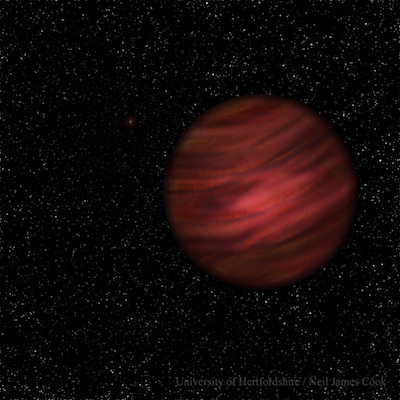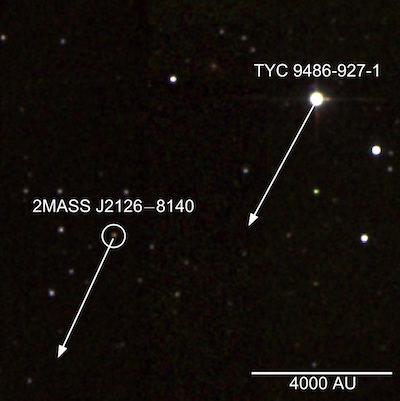The Royal Astronomical Society (RSA) has announced the discovery of a planet that orbits its star at a distance of 1 trillion kilometres. This is easily the furthest distance between a star and a planet ever found. For comparison, that’s 7,000 times further than the Earth is from the Sun. At that distance, a single orbit takes about 900,000 years, meaning that the planet has orbited its star less than 50 times.
The planet itself was discovered in an infrared sky survey by US researchers, and following astronomical protocol it was given the charming name 2MASS J2126.
The line between planet and star isn’t always clearly delineated. Gas giants like Jupiter are considered “failed stars” that didn’t gather enough hydrogen and helium to begin fusion. There’s only so much gas to go around, and in our Solar System, the Sun beat Jupiter to it.
Brown Dwarfs are bodies larger than Jupiter, that came really close to fusion, but failed. They cool and fade over time, and it took additional study to determine that 2MASS J2126 was a planet, and not a Brown Dwarf. In 2014, Canadian researchers confirmed it as a free-floating planet.

A planet drifting through space by itself may not be a rare thing. 2MASS J2126 joined a list of other starless planets discovered in the last few years. The existence of 2MASS J2126 out by itself in space didn’t merit much attention. Only when a relationship was established between 2MASS J2126, and the star TYC 9486-927-1, did things get interesting.
Dr. Niall Deacon, of the University of Hertfordshire, is the lead author of the study. He has spent the last few years looking for young stars that have companions in wide orbits. Deacon and his team pored over lists of brown dwarfs, young stars, and free-floating planets, looking for relationships between them. Eventually they found that the planet 2MASS J2126 and the star TYC 9486-927-1 are both about 104 light years from our Sun, and are moving through space together. “This is the widest planet system found so far and both the members of it have been known for eight years, but nobody had made the link between the objects before,” said Dr. Deacon.
The distance between the two is indeed a surprise, and a signal that we may have to change our thinking around solar system formation. We have a nice tidy theoretical model of solar system formation that’s shaped by what we see in our Solar System. Over billions of years matter clumps together, which strengthens gravity, which draws in more matter. Eventually, if enough gas is drawn together, a star begins nuclear fusion. An accretion disk forms around the proto-star, clumps form in that disk, and planets are formed.
It’s too soon to say if or how this new planet-star pair will change our understanding of solar system evolutions, or if there are other planets yet to be discovered that are orbiting TYC 9486-927-1. According to Simon Murphy of the Australian National University, co-author of the study, “… how such a wide planetary system forms and survives remains an open question.”


so we can detect a planet over 100 light years away with infra-red but still imagining a 10 earth mass planet nine in our home system ? did I miss something ?
@BC: When that planet is roughly 13 times the mass of Jupiter, and (more importantly) glowing brightly in the infrared at a temperature of around 1800K, then the answer to your first question is “Yes.” (http://exoplanet.eu/catalog/jmass_j2126-8140/) By comparison, the ~10 Earth-mass planet orbiting several thousand AU away at a suspected temperature of ~50-100K is NOT so easily detected.
HOWEVER:
As Dr. Pamela will repeatedly remind everyone within shouting distance, it is entirely possible that if said planet exists, then we may have already imaged it many multiple times. We simply haven’t yet made the connection between those disparate images and the fact that they may all be of the exact same object. Modern astronomy has a history of “discovering” previously-imaged solar system objects in exactly this fashion.
It seems more like a binary system of two stars, and not one star with a planet, where is the barycenter?
I believe there is not one. They are travelling together at a distance like two cars on a VERY wide road. No orbiting involved.
@Jeffrey: You may be right, but the authors of the paper would disagree with you: “We adopt a range of 8.4±2.1 km/s for 2MASS J2126?8140’s radial velocity based on our measurements. We note that this radial velocity estimate comes from a very low signal to noise spectrum. However we include this measurement to demonstrate that we have analysed the available archive data for 2MASS J2126?8140 and can find no data which suggests that it is not in a bound system with TYC 9486-927-1.” (https://www.ras.org.uk/images/stories/press/Exoplanets/young_planet_paper.v2.pdf, emphasis mine)
Certainly, it’s too short an observational period to prove beyond ANY reasonable doubt that the two are in fact “A Sun and Its Planet,” but the circumstantial evidence seems persuasive at this point… which is the point of the paper, of course.
And as it says in the article the team discerned that they are not two stars or a star and a BD.